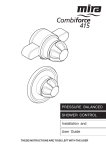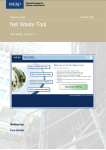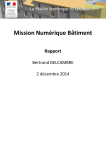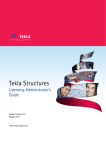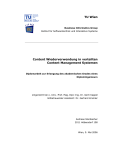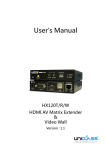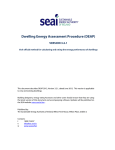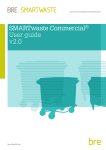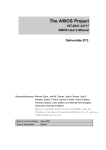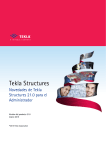Download Resource efficiency through BIM: BIM User's Guide
Transcript
Guidance on resource efficient construction Resource efficiency through BIM: a Guide for BIM Users Shared model and data Design development and optimisation Rapid analysis and quantification Guidance for BIM Users on practical approaches for using the BIM design workflow to help identify opportunities for improving resource efficiency and to help estimate the environmental and cost impacts and benefits February 2013 Issue 1.0 WRAP’s vision is a world without waste, where resources are used sustainably. We work with businesses, individuals and communities to help them reap the benefits of reducing waste, developing sustainable products and using resources in an efficient way. Find out more at www.wrap.org.uk Written by: Adam Mactavish, Ash Turner and Nahim Iqbal Edited by: Dave Marsh, WRAP WRAP and Sweett Group believe the content of this report to be correct as at the date of writing. However, factors such as prices, levels of recycled content and regulatory requirements are subject to change and users of the report should check with their suppliers to confirm the current situation. In addition, care should be taken in using any of the cost information provided as it is based upon numerous project-specific assumptions (such as scale, location, tender context, etc.). The report does not claim to be exhaustive, nor does it claim to cover all relevant products and specifications available on the market. While steps have been taken to ensure accuracy, WRAP cannot accept responsibility or be held liable to any person for any loss or damage arising out of or in connection with this information being Document reference:or[e.g. WRAP, 2006, Report Name (WRAP TYR009-19. by…..Banbury, WRAP] inaccurate, incomplete misleading. It is the responsibility of theProject potential user of a Report materialprepared or product to consult with the supplier or manufacturer and ascertain whether a particular product will satisfy their specific requirements. The listing or featuring of a particular product or company does not constitute an endorsement by WRAP and WRAP cannot guarantee the performance of individual products or materials. This material is copyrighted. It may be reproduced free of charge subject to the material being accurate and not used in a misleading context. The source of the material must be identified and the copyright status acknowledged. This material must not be used to endorse or used to suggest WRAP’s endorsement of a commercial product or service. For more detail, please refer to WRAP’s Terms & Conditions on its web site: www.wrap.org.uk Contents 1.0 2.0 3.0 4.0 5.0 6.0 7.0 8.0 9.0 Introduction ................................................................................................. 1 Resource Efficiency in Construction ............................................................. 2 2.1 Overview ................................................................................................... 2 2.2 Opportunities to improve resource efficiency ................................................ 2 2.3 Why focus on resource efficiency? ............................................................... 3 2.4 Measuring performance .............................................................................. 4 2.5 Resource Management Plans (RMP) ............................................................. 5 Opportunities for resource efficiency through BIM ...................................... 6 Using BIM to be more resource efficient ...................................................... 8 Scoping ....................................................................................................... 12 5.1 Determine scope ...................................................................................... 12 5.2 Agree the approach .................................................................................. 13 5.3 Integrate with BIM workflow ..................................................................... 13 Action planning........................................................................................... 15 6.1 A structured process to action planning...................................................... 15 6.2 Identifying resource efficiency actions........................................................ 16 6.3 Using BIM to plan actions ......................................................................... 17 6.4 Identify priorities...................................................................................... 21 Estimating .................................................................................................. 22 7.1 Overview of the approach ......................................................................... 22 7.2 Creating an initial estimate........................................................................ 23 7.3 Refining the estimate ............................................................................... 25 7.4 Adjusting for resource efficiency actions..................................................... 25 7.5 Data requirements ................................................................................... 26 Monitoring .................................................................................................. 29 Reporting.................................................................................................... 31 Appendix A Resource efficiency hotspots ......................................................... 32 Resource efficiency through BIM: a Guide for BIM Users 1.0 Introduction The adoption of Building Information Modelling and Management (BIM) is a major evolution in the ways in which information on construction projects is generated, shared and managed. BIM brings the potential for widespread efficiencies in project delivery. This Guide considers just one of these: the more efficient use of natural resources, and specifically focuses on the role of the BIM manager in helping deliver these benefits. Resource efficiency involves achieving the required project outcomes using fewer resources (carbon, energy, materials, and water) resulting in reduced impacts (climate change, resource depletion, carbon emissions, water scarcity, and project costs). Ultimately, successful organisations will be able to closely manage their use of increasingly scarce and expensive resources; demonstrating greater value for money by reducing costs and meeting environmental objectives. BIM is not essential to improving a project’s resource efficiency. However, incorporating resource efficiency into BIM implementation makes sense because BIM processes and data can be used directly to achieve efficiencies and also to help estimate performance and identify the biggest opportunities to save money and carbon. This Guide is part of a series of complementary guidance on using BIM effectively to improve resource efficiency in construction projects. Information Note A succinct summary for senior decision makers in projects and construction companies so they can buy-in to the process. BIM Manager’s Guide (this Guide) Shows how resource efficiency can be incorporated into an organisation’s BIM processes, datasets and methods. BIM User’s Guide Explains practical approaches for using the BIM design workflow to help identify opportunities for improve resource efficiency, and to help estimate the environmental and cost impacts and benefits. This Guide does not focus in detail on BIM itself and assumes that the reader is suitably familiar with BIM tools and delivery processes; rather it considers how they can be applied to the challenge of making better use of construction resources. Other WRAP publications provide further detailed information on resource efficiency. Throughout the Guide key sources of further information are indicated in the format below. Further information on resource efficiency www.wrap.org.uk/construction Background information and articles on BIM www.thenbs.com/topics/bim www.building.co.uk/bim Resource efficiency through BIM: a Guide for BIM Users 1 2.0 Resource Efficiency in Construction 2.1 Overview What? Resource efficient construction makes best use of materials, water and energy over the lifecycle of built assets to minimise embodied and operational carbon. This prioritises consideration of: reducing materials use and wastage; increasing reuse and recycled content, and enabling reuse and recyclability at end of life; matching the durability and lifespan of assets to proposed service life; using resources with no scarcity and source security issues; using products with lower embodied carbon and embodied water; reducing energy and water use during construction; and enabling energy efficiency and water efficiency in use. When? Resource efficiency opportunities exist throughout the construction lifecycle – including product manufacture, design, construction, operation, refurbishment, and at end of life. Why? Business benefits, including: reducing costs and project risk; stimulating innovation; demonstrating compliance with regulations, standards and planning requirements; supporting industry objectives; and improving reputation. Environmental benefits, including: helping to achieve climate change targets; reducing depletion of natural resources; and helping to tackle water scarcity. How? Best results will be achieved where there is a strong client lead together with coordinated action from the supply chain utilising effective Resource Management Planning Process and technical innovations can support resource efficiency in construction, including BIM, Lean, offsite construction and logistics solutions. 2.2 Opportunities to improve resource efficiency Whilst much of this Guide focuses on efficiencies in the design and construction process, consideration must also be given to the impact of design decisions on operational performance, the longevity and flexibility of the asset and its end of life management. For a new or refurbished building, the key opportunities include: Prepare Understand the site and the opportunities and constraints it presents. Target the project’s resource efficiency objectives to reflect site specific considerations. Resource efficiency through BIM: a Guide for BIM Users 2 Design Develop the minimum amount of space that will fully achieve the functional requirements (e.g. reducing the overall space requirement by improving the net to gross ratios or creating flexible multiuse spaces). Design an operationally efficient (including energy, water and facilities management) building that is flexible to accommodate future changes in use. Use as few materials as necessary. Choose materials with low lifecycle impacts (e.g. embodied energy, water and carbon) and a durability that reflects their life span within the building. Source products that make good use of resources by using recycled content, sustainably sourced renewable materials and energy, material and water efficient manufacturing and supply. Construct Manage materials to minimise costs and wastage during transport, delivery and installation. Maximise the recovery and reuse of surplus material and wastes from construction and if removed at demolition / refurbishment. Use energy and water efficiently on site. Operate Enable efficient operations by encouraging responsible use, careful management and maintenance of equipment and facilitating investment in new more efficient technologies. For any given project the priorities and opportunities will vary considerably. Successfully reducing resource use on a project requires the input and collaboration of many parties and the ongoing sharing of information. BIM tools and processes have an important role in this process by helping project teams identify, investigate and implement these opportunities in a co-ordinated way. BIM data also provide a powerful resource for helping to estimate resource efficiency, benchmark and identify improvement opportunities thereby informing decision making, and monitoring and reporting outcomes. 2.3 Why focus on resource efficiency? The Government’s Low Carbon Construction Action Plan, and the subsequent establishment of the Green Construction Board all signify that the UK construction sector is critical to the growth and decarbonisation of the economy. To meet this challenge it is imperative that the industry is able to work more efficiently, getting better value for the cost and carbon involved in project delivery. Resource efficiency delivers powerful benefits by: reducing project costs; demanding a focus on quality and co-ordination throughout the design and construction process; encouraging innovation and a creative approach; and reducing the environmental impacts of construction. Resource efficiency through BIM: a Guide for BIM Users 3 The importance of making efficient use of all resources will continue to grow as global demand for materials, energy and water increases and it becomes harder to dispose of waste. Those organisations taking proactive steps to be more resource efficient will be more cost competitive and better able to meet their stakeholders requirements, be they customers, policy makers, employees or regulators. BIM is a key tool helping the industry achieve these efficiencies; making better and wider use of information to co-ordinate, test and improve decision making from the outset of a project to its completion and use. However, the adoption of 3D modelling and other BIM tools will not in itself change behaviours and performance. BIM Users are responsible for helping their organisation maximise the benefits of adopting BIM. This includes making good use of the data in each model to inform resource efficient design, construction and asset management, and by using the processes established for timely provision of robust and accessible information. 2.4 The Low Carbon Construction Action Plan www.bis.gov.uk/policies/business-sectors/construction/low-carbonconstruction-igt Green Construction Board www.greenconstructionboard.org Measuring performance Measuring the impact of any resource efficiency actions is important in assessing their value for money. BIM is a useful tool to support measurement but nonetheless it is important to take a proportionate approach and ensure that time spent on measuring performance is justifiable in the context of overall project and the potential savings. A wide range of metrics could be used to measure the different elements of resource efficiency, however it is recommended that the initial focus is on few priority metrics. The following metrics are considered to generally represent current priorities of resource efficient construction: Embodied carbon, including emissions associated with manufacture, supply and installation of construction products (tCO2e). Non renewable energy use from onsite activities (MJ GCV, split by energy type). Waste produced (tonnes, split by hazardous, non-hazardous and inert and whether this is construction, demolition or excavation waste). Recycled content of materials used (% by value). Water use onsite (m3, split by water source). These metrics do not address all response efficiency elements, however they enable practical action through design and construction, and provide a robust starting point to inform decision making and performance benchmarking. The above metrics can also be used to report performance indicators by dividing by an appropriate measure of either the spatial area developed (e.g. m2 gross internal floor area), the function delivered (e.g. per pupil, bedspace, patient, etc) or for specific project elements (e.g. per m2 of external wall area). In combination, these measures can enable project teams and clients to assess if their design and specification is resource efficient and if it has Resource efficiency through BIM: a Guide for BIM Users 4 been delivered in an efficient way. See section 7 for further discussion on benchmarking and reporting performance. 2.5 Resource Management Plans (RMP) Resource management planning is an effective process for improving the resource efficiency of a project. The RMP defines the scope and priorities for resource efficiency for the project and provides a framework for recording actions, estimating their impacts, monitoring performance and reporting. Many of the actions within an RMP are routinely undertaken on many projects. For example, site waste management planning, design co-ordination and clash prevention, logistics strategies, etc. In addition, depending on the scope determined for the project, an RMP might include actions to reduce embodied carbon or increase recycled content during product selection. BIM data and tools can have a significant role in improving project resource efficiency, and these opportunities (see Section 3 for examples) should be recognised within the RMP and actions defined for ensuring that BIM activities support the project’s resource efficiency objectives. Similarly, the project BIM Execution Plan should specify in more detail how BIM will be used to input to the RMP, for example by defining the processes, tools and data that will be used at different stages (see Section 4 for further information). Further information on Resource Management Plans www.wrap.org.uk/construction Further information on materials logistics planning www.wrap.org.uk/constructionlogistics Resource efficiency through BIM: a Guide for BIM Users 5 3.0 Opportunities for resource efficiency through BIM BIM offers the potential for streamlining operations that were previously expensive and inefficient, through aspects including: efficient management of project data; improved collaboration between project teams; enhanced visualisation and multi-dimensional analysis of the design and programme; and real-time management of site logistics/ coordination. Many of these attributes inherent to the use of BIM will deliver resource efficiency benefits, from simple paper efficiencies to clash prevention and optimisation of ducting routes. However, there are many further opportunities for BIM to support resource efficient design and construction which have until recently remained under exploited. These opportunities centre on BIM’s ability to increase the visibility of project data; some of which are suggested in Figure 1. Figure 1 Examples of opportunities for improving resource efficiency from BIM adoption 3D visualisation & design coordination •Reduced wastage through clash prevention •Enhanced control of site activities (eg laser guidance of plant) •Visualisation of 'innovative' design measures reducing the risk of needing to rework Project team collaboration •Reduced waste from better co-ordination across the supply chain, including offsite manufacturers •Improved information sharing and development of collaborative solutions Realtime construction sequencing/ execution •Reduced programme and associated reduction in site impacts •Improved logistics both (deliveries and on site) reducing waste and vehicle movements The extent to which the above benefits are achieved depends on the depth of BIM implementation across the project team and wider supply chain. Not all of these initiatives (e.g. laser guidance systems) are widely used at present however they are being adopted by leading companies for larger projects because of the competitive advantage they provide. Figure 2 illustrates a simplified development cycle of a BIM model, encouraging the continuous quantification and analysis of shared project information. Opportunities to improve resource efficiency present themselves at all stages of the cycle. Resource efficiency through BIM: a Guide for BIM Users 6 Figure 2 Simplified development cycle of BIM model Shared model and data Rapid analysis and quantification Design development and optimisation BIM provides a comprehensive database of project dimensions, specifications and technical information. This presents early opportunities to conduct rapid, analyses of proposed designs offering immediate feedback on proposed alternatives. Such calculations enable the realistic assessment of a project’s performance, identifying areas that present potential opportunities to improve resource efficiency which are then fed-back into the design process as a series of actions. Materials quantity Rapid quantification and analysis of design options facilitates the selection of those that meet project requirements with the lowest material demands. Through early analysis, teams can identify more efficient building components to achieve, for example, lightweight structures. Materials wastage The quantity data held within BIM models support more accurate estimations of wastage quantities thereby helping to identify core waste streams and implement effective waste management strategies. BIM data can be combined with waste performance benchmarks to identify priority opportunities to reduce waste generation. The 3D visualisation provided by a BIM helps identify coordination issues at an early stage, thereby eliminating the need for costly and wasteful rework Embodied carbon BIM can be used to conduct sophisticated environmental analyses of project materials to estimate the embodied and operational carbon impact of design options. Resource use analysis of the new Leeds Arena enabled an 8% reduction in material requirement. Design refinements at Manchester Central Library refurbishment resulted in a 50% reduction in ground slab thickness, saving 300m3 of concrete. A recent assessment by the Gilbane Building Company identified 2,400 clashes detected during the design stage of a $51m project (estimated at $2,500 per clash). 1,800 tonnes of CO2e was saved through the use of PFA following rapid BIM analysis of the carbon impact of cement replacements on the University of Texas Health Science Centre project. Resource efficiency through BIM: a Guide for BIM Users 7 4.0 Using BIM to be more resource efficient In common with non-BIM projects, improved resource efficiency is most effectively achieved through the following steps: 1 Scoping to define the scope and approach to resource efficiency during the project. (Section 5) 2 Action planning at key stages to identify opportunities, investigate their effectiveness and implement within the project. (Section 6) 3 Estimating the impact of the agreed actions on the resource efficiency of the project. (Section 7) 4 Monitoring resource use, during construction. (Section 8) 5 Reporting performance at key stages to check progress, develop benchmarks and provide feedback for future projects. (Section 9) 6 Feedback on the differences between estimated and actual performance and update relevant benchmarks. Figure 3 summarises the process, suggesting that there should be five reporting stages during the project. The first defines the scope, key opportunities and performance objectives based on the high level brief from the Client. This is followed by reports, aligned with project reporting, presenting agreed actions and their estimated impact beginning with the design concept and then progressing through to more targeted analysis of specific elements within the design and specification and the approach to selecting and managing specific products. Ultimately the as-built performance of the project is determined from monitoring of construction activity. The data within the as-built model should provide the basis for ongoing management of resource use during the use and maintenance of the built asset. At the end of the project it is sensible to review the performance achieved and compare this to design stage estimates. This review should identify key learning and should also be used to update relevant benchmarks. Ideally, reporting should be collated and managed within a project Resource Management Plan (RMP). Furthermore, the five reporting steps reflect the five ‘data drops’ required for public projects being delivered through BIM. However, the scope and number of reviews and reporting should be determined in the scoping phase. This approach follows an idealised design process. In reality, the level of development will vary for different parts of a project and there may be a need to revisit actions at a later stage where, for example, design or specifications change. Where the project delivery method results in the design and construction of different project elements progressing at varying speeds (e.g. a construction management approach), the approach should be flexed to reflect the level of detail and potential for change of each project element. It is important to ensure the approach taken, and so the effort, is proportionate to the project size and complexity and the benefits being sought. Resource efficiency through BIM: a Guide for BIM Users 8 Some of the key activities and outputs at each stage are shown in Table 1. Table 1 Activities at different project stages Project stage 1) Preparation Activity Scope and establish resource efficiency approach. To include: o client and or other requirements / targets; o scope of assessment (overall and at each stage); o data requirements (e.g. parameters to be included within objects in the BIM model); o responsibilities and timing; and o methods to be applied (see Section 4) Review of performance benchmarks for other similar projects. Output Definition of approach within BIM execution plan and other project documentation 2) Concept design Identify strategic opportunities to enhance resource efficiency and develop actions, e.g. to: o reduce overall development area; o use resource efficient material options for key elements (e.g. structure); o make use of resources already onsite or available locally; and o use offsite construction where appropriate. Investigate, quantify and evaluate actions. Agree and implement recommended actions into concept and define further work required at next stage. Concept report describing: current performance in relation to benchmarks / targets; actions adopted; and key priorities and opportunities to be considered at subsequent project stages. 3) Developed design Review priority project opportunities (from concept stage) to develop actions, e.g. to: o reduce material use (e.g. through design refinement and optimisation); o increase durability; o use more resource efficient materials; and o use products that are efficient in use Investigate, quantify and evaluate actions. Agree and implement recommended actions into design and define further work required at next stage. Engage with potential suppliers of key materials / products and specialist trades. Design stage report describing: current performance in relation to benchmarks / targets; actions adopted; key actions to be required of construction teams (to be embedded in their scope of work); and key priorities and opportunities to be considered at subsequent project stages. 4-5) Technical and specialist design Review priority project opportunities and develop actions to: o select cost competitive resource efficient products that meet the required specification; o minimise resource use on site, e.g. energy and water in site offices, plant, vehicles, etc; and o minimise site waste through planning, sequencing, clash prevention, site logistics, working methods, etc. Engage with key suppliers and specialist trades. Preconstruction report describing: current performance in relation to benchmarks / targets; actions adopted; and projected as built performance and approach to monitoring actual performance. Benchmark range for the project based on development characteristics and size Resource efficiency through BIM: a Guide for BIM Users 9 Project stage Activity Identify monitoring methods to ensure implementation of the actions. Output 6) Construction Manage and deliver agreed resource efficiency actions. Monitor performance and identify corrective actions where necessary. Report as built performance. As-built report that records: actual performance in relation to benchmarks and design stage projections; corrective actions implemented; and relevant information for handover to client / occupier. 6) Use and aftercare Record and benchmark project performance and any key materials / elements. Review as-built vs estimated performance and identify lessons for future projects. Update resource efficiency data on components / elements as appropriate. Supply COBie data for incorporation into FM / building management system, to ensure efficient operation and repair, maintenance and improvement. Supply information to enable deconstruction at end of life. Feedback report presenting overall performance benchmarks, lessons learnt and actions to update base data for future projects. A structured process for identifying and implementing opportunities for Designing out Waste (but can equally be used for other resource efficiency aspects) www.wrap.org.uk/designingoutwaste Information on effective management of resources during operations, including Facilities Management www.wrap.org.uk/fm Resource efficiency through BIM: a Guide for BIM Users 10 Figure 3 Steps in building resource efficiency into a BIM based project process Resource efficiency through BIM: a Guide for BIM Users 11 5.0 Scoping At the outset of the project it is important to: determine the scope of resource efficiency aspects that are relevant to the project; agree how these will be assessed together with responsibilities and protocols that will be adopted; and integrate these into the BIM workflow, ensuring that the relevant information is recorded in the project’s BIM Execution Plan. 5.1 Determine scope BIM makes it easier for project teams to access detailed information and thereby assess a project in greater detail at an earlier project stage. However, it is important to focus time and effort on those areas of most significance and the project team should not attempt to quantify and address all possible resource impacts. The scoping stage is important in focusing attention on areas of real significance. Table 2 summarises the different aspects of resource efficiency for construction. These aspects will be more or less relevant depending on the nature of the project, and the objectives and priorities of the client and project team. Table 2 Aspects of resource efficiency Resource efficiency aspect Materials use Waste Objective To reduce material use whilst still providing the required functional performance. To minimise wastes and recover wastes in line with the waste hierarchy Re-use and recycled content Durability & life span To increase the use of reused and recycled content Scarcity & security To avoid the use of materials that are scarce now, or expected to be in the future, where more abundant and equally suitable alternatives exist. Products with low embodied carbon and water Reducing energy and water use in construction Operational energy and water use Hazardous materials To choose specifications with low embodied carbon and water impacts whilst still providing the required functional performance To use products and designs that are: appropriately durable for their intended use; capable of being used flexibly; easily adaptable to change of use throughout their life; and capable of being reused at their end of life. To minimise the energy and water used to deliver the project, and to use lower impact sources of energy or water wherever possible To provide assets that are efficient in their use of energy and water To avoid the use of hazardous materials where suitable alternatives are available, and to effectively manage these materials if they are present in a project (e.g. in an existing structure) or their use is unavoidable. Resource efficiency through BIM: a Guide for BIM Users 12 The scope of resource efficiency for the project should be informed by the answers to the following questions: What are the project resource efficiency aspects (see Table 2) that need to be addressed because of planning, corporate commitments or legislation? Which resource efficiency aspects will be most impacted by this project? In which resource efficiency aspects is the project team already experienced and capable of achieving improved performance without significant effort? Depending on the answers to the above questions those resource efficiency aspects that need to be addressed should be identified and any specific requirements (e.g. client policy or planning requirements) noted. It may be that some resource efficiency aspects should be assessed in detail while others require less detailed investigation but should not be scoped out altogether. 5.2 For further information on scoping resource efficiency aspects see Resource Management Planning guidance www.wrap.org.uk/construction Agree the approach Once the scope is determined (and which should be reviewed and updated as the project progresses), the project team should agree the approach to assessing each priority area. This might be a relatively simple set of qualitative actions drawn from the expertise of the project team or could involve more detailed assessment and quantification of the relative merits of different options (see Estimating in Section 7). The right approach will depend on the scale of the project, the significance of the opportunity and the skills of the project team. Reference should be made to key metrics that enable performance measurement and benchmarking (see sections 2.4 and 7). 5.3 Integrate with BIM workflow The project’s BIM Leader should be confident that they understand and are able to support these uses of BIM for each relevant resource efficiency aspect. They should also ensure that the project’s BIM Execution Plan clearly sets out: what will be done; who will do it; when it will be done; the tools they will use; and the data they will need, its source and how it will be made available The BIM Execution Plan should also reference the project RMP. Resource efficiency through BIM: a Guide for BIM Users 13 As with most uses of BIM beyond visualisations, it is imperative that good modelling practices are applied. For example, there should be no gaps in geometry and projects must be built from appropriately classified objects/families. If the base model is of insufficient quality then subsequent analysis will be compromised. The creation of resource efficiency content for template BIM execution plans is considered further in Resource Efficiency through BIM: BIM Manager’s Guide together with some suggested approaches for incorporating resource efficiency within a typical plan. www.wrap.org.uk/construction Resource efficiency through BIM: a Guide for BIM Users 14 6.0 Action planning Improvements in resource efficiency are achieved through actions, be they changing less efficient practices or selection of products with high recycled content or low embodied carbon. Action planning is therefore the key step in any RMP. Actions could include: Design changes – e.g. to minimise resource use. Specification changes – by selecting specifications that have lower resource impacts e.g. by having lower embodied carbon, reduced water / energy use in construction, etc. These might include review of different construction techniques and the benefits of offsite construction. Management actions – e.g. to minimise impacts associated with logistics, wastage etc. These might include strategies for design co-ordination and management of specific activities / products onsite. Procurement actions – e.g. to specify performance standards for the procurement of products (e.g. concrete blocks or carpets) or services (e.g. drylining, excavation / demolition). Performance standards might include minimum levels of recycled content or maximum levels of wastage. It is important to undertake action planning in a structured way, to ensure that: opportunities are not missed; decisions can be made objectively based on quantified benefits; and the solutions are embedded into the project and can be communicated effectively to the project team. 6.1 A structured process to action planning Figure 4 shows a three-step process that is tried and tested in providing this structure effectively. It can be easily applied to all types of project, whether relating to buildings or civil engineering, demolition, new-build or refurbishment. The following sections provide further guidance on elements of this process: Identification – sections 6.2 and 6.3 Prioritisation – section 6.4 Quantification – section 7 Resource efficiency through BIM: a Guide for BIM Users 15 Figure 4 Design for Resource Efficiency process identify investigate Review the project to identify as many potential opportunities for action as possible to improve the resource efficiency. Then rationalise the list of opportunities to prioritise those which will provide the biggest reductions and be easiest (and most cost efficient) to implement. Investigate the top opportunities further to ascertain their viability. This may include aspects such as compliance with standards, buildability, and impact on safety. It is important to quantify the benefits and impact of each opportunity so that decisions about which solutions to pursue further are made objectively based on evidence. Embed the final solutions in the project through the plans, specifications, project reports and procurement process. Record details of the solutions in the RMP. These actions will help to ensure the design solutions are implemented on site. implement 6.2 Identifying resource efficiency actions The list of potential actions to improve resource efficiency in a project can be extensive. Some can result in measurable impacts whilst others are more difficult to quantify but no less valuable. Table 3 and Figures 5 and 6 provide a few examples. Actions can be based on: what has worked well on previous projects – it is therefore worth maintaining a library of successful initiatives; expert views based on the nature of the project and the materials / activities involved; and estimated improvement potential from changing assumptions – e.g. reduced wastage rates, higher recycled content, use of water efficient taps, etc. Undertaking a design review workshop is an effective way of identifying opportunities for actions and WRAP has published a Facilitator’s Guide with supporting material for running a workshop (although this Guide is focussed on Designing out Waste, the approach can be equally used for all resource efficiency aspects). WRAP’s guidance on Resource Management Plans also provides further information on the Action Planning process. The type of action that is suitable / possible will change as the project progresses. As with any design process the most valuable opportunities arise early on with decisions about the strategic concept (form, massing, construction method, etc). After this point there are Resource efficiency through BIM: a Guide for BIM Users 16 further improvement opportunities within the framework established by the design concept. For example, by refining the specification for specific components and ensuring effective design co-ordination to reduce wastage, etc. Table 3 Example resource efficiency actions, and resulting impact Example action Impact Reducing the building footprint by sharing spaces Reducing material use and embodied carbon Optimisation of design elements, e.g. foundations, beams, ducting, etc using algorithms in a BIM model Use of cement replacements within suitable concrete designs Procurement of dense blockwork that contains high levels of recycled materials Planning to ensure that site offices use grid electricity from the outset of site works Specifying minimum energy efficiency standards for site offices, vehicles and plant Specifying maximum water use levels for taps, toilets, showers, etc Incorporating component labelling and deconstruction planning within new build elements Designing building cladding to be demountable and replaceable Developing expansion / change of use plans Reducing material use and embodied carbon 6.3 Reducing embodied carbon and potentially increasing recycled content Increasing recycled content Reducing embodied carbon Reducing site energy and embodied carbon Reducing water in use Designing for deconstruction Increasing durability and lifespan Increasing durability and lifespan Design review workshop, facilitator’s pack www.wrap.org.uk/content/design-review-workshop-facilitators-pack Example solutions for improving resource efficiency, provided in design guides and case studies www.wrap.org.uk/designingoutwaste Using BIM to plan actions One of the major advantages of BIM is that these tools can provide project information at a time when change is still possible. Specifically, BIM can contribute to the development of resource efficiency actions as: a source of information on projected resource use and opportunities Section 7, considers how projections of resource use and key opportunities can be identified using BIM data; and tools for improving resource efficiency Many of the capabilities of BIM tools can be used to help achieve resource efficiencies, some examples are described in Table 4 and illustrated in Figures 5 and 6. Actions that require information to be obtained (e.g. a schedule of material quantities for specified elements) or necessitate specific tests on the model (e.g. simulation of space utilisation) should be clearly defined in the project’s BIM Execution Plan and be referenced within the RMP. Resource efficiency through BIM: a Guide for BIM Users 17 Table 4 Possible roles for selected BIM tools in increasing resource efficiency BIM Use Design authoring Resource efficiency opportunities Quantification, selection and analysis of materials. Evaluation of options for meeting project goals. Integration of specific products or prefabricated elements providing the opportunity to optimise design and manufacturing workflows to create greater efficiency. Example tools1 Autodesk Revit ArchiCAD Bentley AECOsim Vectorworks Tekla Structures CADduct Autodesk Civils 3D Use of visualisation techniques to minimise design changes during construction and to help co-ordinate site teams. Optimisation of design features Specification development Building environmental analysis Use of point cloud imaging to build on detailed 3D representation of the site or existing building, providing a robust basis for design and minimising surprises when on site. Use of algorithms within the BIM tool to reduce materials use or wastage by optimising elements of the building design, e.g. the structure or building services. Addition of resource efficiency criteria into component specifications and identification of compliant products. Improved water and energy efficiency and use of materials with lower embodied carbon. 3D design coordination Preventing waste prior to onsite construction through multi-disciplinary design coordination and clash prevention. Construction sequencing Analysing and optimising construction method and activities to prevent unnecessary activities and waste creation. Analysis of existing topography and the materials generated / required to deliver a project. Quantification and analysis of materials aligned to enable informed decision making on material use and reduction opportunities Cut and fill balance Cost Estimation Autodesk Revit Structure Autodesk Revit MEP Autodesk Civils 3D NBS Create Autodesk Ecotect Green Building Studio EcoDesigner IDA Indoor Climate &Energy Simergy ArchiWIZARD DesignBuilder IES Tekla BIMsight Navisworks (clash detection) Solibri Model Checker Bentley Navigator Navisworks (timeliner) Synchro 12D Autodesk Civils 3D Causeway BIMMeasure Autodesk Quantity Takeoff (QTO) Exactal Cost X Dprofiler Vico iRIB Two 1 A wide range of other tools are available and BuildingSMART maintains a list of over 100 tools that have been certified as compliant with its interoperable IFC data structure. By listing these tools WRAP is not providing a recommendation as to their suitability or performance – the list is simply provided for information. Resource efficiency through BIM: a Guide for BIM Users 18 Figure 5 Resource efficiency opportunities at different stages of a building project Resource efficiency through BIM: a Guide for BIM Users 19 Figure 6 Resource efficiency opportunities at different stages of a infrastructure project Resource efficiency through BIM: a Guide for BIM Users 20 6.4 Identify priorities Prioritising the long list of potential actions is important, to focus time and effort on those that are likely to have the greatest impact on each resource efficiency aspect and can be implemented most easily (i.e. are most feasible and viable). For example, for a new build office it would usually be sensible to focus on the structure, cladding and roof. In many cases the project team will have the experience and evidence from previous projects to be able to identify priorities. Quantification of potential actions (see section 7) can be highly valuable in informing decisions. Additional guidance can be found in the information sources. The project team should also review each action and decide those that are: appropriate for the project and should be implemented immediately; are appropriate for the project and should be implemented at a future project stage; may be appropriate for the project subject to further investigation at a future stage; or are not appropriate and will not be implemented. Each action, its impacts and status should be recorded in the project RMP. For further guidance on prioritising opportunities see: WRAP’s design review process provides a structured workshop approach to identifying and prioritising opportunities www.wrap.org.uk/content/design-review-workshop-facilitators-pack Case studies for similar project types www.wrap.org.uk/construction Information from modelling tools, for example WRAP’s Designing out Waste tools, provide an indication of key sources and overall cost of waste based on basic project information www.wrap.org.uk/designingoutwaste RICS Methodology to calculate embodied carbon of materials contains practical guidance on prioritising building elements www.rics.org Published benchmarks (see Section 7 for examples) Resource efficiency through BIM: a Guide for BIM Users 21 7.0 Estimating Estimating resource use can be a simple and powerful aid in reducing the cost and environmental impact of a construction project. BIM tools make it comparatively easily to generate schedules of quantities and these form the building blocks to estimate resource use and identify opportunities to be more resource efficient. Two approaches are possible: Exporting data from the BIM tool for analysis within dedicated software Suitable for more sophisticated analysis, action planning and benchmarking. Analysis within the BIM tool Suitable for simpler estimation and where the project team has expertise in developing the necessary schedules, calculations and analysis. Further information on setting up corporate processes for estimating resource use is contained in Resource Efficiency through BIM: BIM Managers guide. For either approach to work successfully it is imperative that good modelling practices are applied. For example, there should be no gaps in geometry and projects should be built from appropriately classified objects/families. If the base model is of insufficient quality then subsequent analysis will be compromised. 7.1 Overview of the approach Making estimates of a project’s resource use and impacts involves: 1 Gathering high level project information – on the extent and type of different project elements; 2 Applying impact factors and performance benchmarks – to estimate impacts and opportunities for improvement; 3 Refining estimates – by adding more detailed information on elements where opportunities are most significant; and 4 Adjusting – to account for the effect of planned actions. Ultimately it is up to the project team to determine the level of detail that should be applied when estimating resource use and impacts. If more detail can be extracted from the building model the estimate will be more informative and will be of greater use in pinpointing where actions can have most benefit. Irrespective of the approach, it is important that the BIM Co-ordinator and relevant members of the project team are aware of the proposed method and their role in its delivery. The approach should therefore be described in the BIM Execution Plan. Figure 7 summarises the steps involved in developing an initial estimate, refining the estimate and then making adjustments to reflect the impact of specific actions. Resource efficiency through BIM: a Guide for BIM Users 22 Figure 7 Approach to estimating resource efficiency Gather high level project information Quantify project resource use Apply impact factors / benchmarks Refine information on priority elements Initial estimate of resource efficiency and priorities Use estimate to identify potential actions Adjust estimate to reflect agreed actions Resource Efficiency Actions Revised estimate to report and then refine in next phase 7.2 Creating an initial estimate Follow these steps to create an initial estimate of project resource efficiency: 1 Create a schedule (see Box 2) within the BIM tool showing the type and quantity (area / number / volume /mass) of each project element. 2 Review this data and consolidate elements so that the schedule is simplified and contains information on the quantity of different generic elements. 3 Combine the quantity of each element with resource impact benchmarks (a list of data sources is at the end of section 7.5) and impact ‘flags’ (Appendix A) that denote a Resource efficiency through BIM: a Guide for BIM Users 23 potentially significant resource impact. 4 Total the resulting resource use and impact estimate, then identify opportunities for improvement, i.e. those project elements where: resource use and impact are highest; there are significant opportunities to reduce resource use / impacts by moving towards the Good Practice benchmarks; or there are resource efficiency ‘flags’ relating to the element indicating that some of the resources used in the element may need careful management. 5 Use the estimate and most significant opportunities as a tool for identifying possible improvement actions and checking that the actions previously identified cover the right aspects of the project. The initial estimate will be relatively high level and will present a range of the possible performance of the project. This estimate can subsequently be refined and developed to incorporate more project detail and the impact of resource efficiency actions (see below). Box 2: Creating a schedule One of the strengths of BIM is that it is easy to extract and manipulate schedules of quantitative design information. A schedule is typically generated by creating the appropriate ‘view’ on the data within the BIM design authoring tool. The content of the schedule can then be refined by adding or removing fields / criteria / parameters. For example, within Autodesk Revit the approach involves selecting the ‘schedules/quantities’ tool within the ‘view’ menu. Ideally, the BIM Manager will have set up a set of template schedules for use in resource efficiency analysis, however, a new schedule can be created easily by generating a ‘multi-category’ schedule that combines grouped information on the core project elements. The minimum data fields required for analysing resource efficiency are the quantity, the element description and ideally the classification code (i.e. Uniclass / Omniclass). The classification code will make it easier to assign reference resource efficiency information to each element. Where the objects used in the model have embedded resource efficiency data this can also be built into the schedule. Resource efficiency through BIM: a Guide for BIM Users 24 For further information on setting up schedule templates see Resource efficiency through BIM: BIM manager’s guide www.wrap.org.uk/construction 7.3 Refining the estimate The initial estimate can be refined to provide greater detail in priority areas during subsequent iterations of the resource efficiency analysis (i.e. at Design, Preconstruction and As-Built stages). Priority areas might be those where more design information has become available or where there is a high resource impact. The process for refining the estimate is the same as for generating the initial estimate except that the generated schedule will contain more information on the components contained within the discrete elements. The component schedule should be combined with relevant resource impact data to provide more detailed information on impacts and improvement opportunities. A further level of detail will be to add information on the specific performance of the construction products that have been selected for use in the project, or to develop a more detailed estimate of energy / water consumption for specific high impact site activities by considering the relative performance of different construction methods or site plant. By the time the analysis reaches the end of the preconstruction stage it would be reasonable to expect that product specific information has been added for the components responsible for the highest resource impacts, e.g. greatest embodied carbon, construction energy use, etc. 7.4 Adjusting for resource efficiency actions At each resource efficiency review the estimated performance should be adjusted to take account of planned actions that will improve performance (see Section 6). The estimate can be adjusted by: amending the project model – by incorporating a design change that alters the quantity of materials used for a specific function with associated reductions in resource impacts; changing using a lower impact resource – for example, if an action involved an early switch from diesel generators to grid or even renewable electricity, then the factors used to estimate the impacts from site energy use would need to be adjusted accordingly; or estimating better than ‘standard’ performance – for example, where an action will result in reduced wastage then this can be taken into account by moving the relevant wastage rate towards the good practice benchmark. Similarly, it might be agreed that a particular element / component will have a maximum embodied carbon or minimum recycled content level. These requirements should be added to the relevant part of the specification2. The revised estimate will provide an indication of the likely performance of the project, the most significant opportunities to improve resource efficiency and the impact of agreed 2 If the project team are using a BIM compliant specification tool (such as NBS Create) then resource efficiency information can be linked to the relevant specification elements for each object. Resource efficiency through BIM: a Guide for BIM Users 25 actions. This, together with the action plan list, should be entered into the project RMP and used for project stage reporting (see section 9). 7.5 Data requirements Estimating the impacts of resource use requires a range of reference data, some of the typical requirements are shown in Table 5. Table 5 Reference data required to estimate the impact of resource use Resource impact Materials use Data required volume / area / unit to mass conversions where needed Waste wastage rates for each component element Reused and recycled content recycled content benchmarks showing achievable recycled content levels Embodied carbon – materials carbon in materials embodied carbon (kg CO2e) per unit of resource use, e.g. a Nr, m2, m3 or tonnes Comments Generic reference data is available at an elemental level for many typical elements1. Generic reference data is available at an elemental level for many typical elements1. Generic reference data is available at an elemental level for many typical elements1,2. More detailed information at a component level and / or for specific products can be sourced from published datasets or manufacturers. Generic reference data is available at an elemental level for many typical construction materials3,4. More detailed information at a component level and/or for specific products can be sourced from published datasets or manufacturers. materials transport to site carbon (kg CO2e) per unit of fuel use or distance travelled Energy and water use in construction site energy and water use for high, medium and low intensity site work. source of energy and water, i.e. fuel, grid, electricity, etc. Generic carbon conversion factors are published for different transport types4,5. Generic benchmarks for energy and water use on site (kWh or l per person per day) are available for different broad types of activity6. These use benchmarks need to be combined with impact factors for the specific type of energy or water use5. Much of this information can be incorporated within the Impacts section of the COBie data structure (see Box 1). Therefore, where an organisation’s BIM library supports COBie it should be possible to embed resource efficiency information directly into the systems (i.e. elements) or components used to build the model. Resource efficiency through BIM: a Guide for BIM Users 26 Box 1: The COBie data format COBie (Construction Operations Building information exchange) is a file format for holding information on a facility (e.g. a building). Many BIM design tools can export a tabular representation of the construction project into a COBie Excel spreadsheet. The data in this sheet can then be analysed directly or imported into other compatible tools. The COBie format is based on unique ‘types’, which may be components or groups of components (called systems). Components and/or systems are assigned to spaces (which may be grouped into zones) and floors within the facility. The COBie file provides information on each type and then specifies where different types are used within the facility. Information on the cost and environmental impacts can be assigned at any level (from specific ‘types’ or at the level of the whole facility). Impact information includes: cost and environmental impacts (primary energy consumption, water consumption, climate change (t CO2e) and hazardous and non-hazardous wastes)3 at different stages in its lifecycle (e.g. production, installation, maintenance, replacement, use and reuse); and the duration and repetition of these impacts. The COBie data structure can be used to hold information on resource efficiency performance for each object within a BIM library, it also provides a framework for exporting this information for use in estimation or other forms of analysis. Other resource efficiency aspects such as embodied water, scarcity and durability are currently difficult to quantify using impact factors. Therefore it is more effective to identify those elements / components where these issues might be particularly significant when making component or procurement decisions. Appendix A lists some of the construction components where these issues are particularly relevant. 3 This initial list can be extended to include other impact areas such a recycled content. Resource efficiency through BIM: a Guide for BIM Users 27 1 The Net Waste Tool dataset provides information on mass to volume conversions, wastage rates and recycled content in a wide range of construction components and elements. http://nwtool.wrap.org.uk 2 The Recycled Products Guide provides information on the recycled content on a wide range of standard construction products http://rcproducts.wrap.org.uk 3 The Inventory of Carbon and Energy created by University of Bath 4 The Environment Agency Construction Carbon Calculator uses much of the source date from the Inventory of Carbon and Energy and presents this in as an accessible set of carbon factors for construction products and associated transportation. http://aggregain.wrap.org.uk/sustainability/sustainability_tools_and_ approaches/environment_agency.html 5 Defra guidance and carbon conversion factors for transport www.defra.gov.uk/environment/economy/business-efficiency/reporting 6 Construction Excellence, Environmental Performance Indicators www.constructingexcellence.org.uk Resource efficiency through BIM: a Guide for BIM Users 28 8.0 Monitoring Effective monitoring of construction activities and the creation of an ‘as-built’ BIM model is an increasingly important element of BIM implementation. An as-built model provides significant benefits, including: a digital record of the actual completed project incorporating any design changes that occurred during construction – this is useful for clients and occupiers as a platform for ongoing asset management; a record of programme and site activities; and comparison of design stage estimates with actual practice – to identify learning as to the reasons for deviations from the original design intent. There is a range of techniques used for monitoring actual site activities within BIM. These include electronic tagging of materials and the use of photos and laser scanning to update the model with precise geospatial data. The technology for generating as-built models is rapidly evolving and so these techniques are not considered further in this guide. From a resource efficiency perspective key objectives of monitoring are to: gather information about overall resource efficiency performance in the areas prioritised for the project; and demonstrate the key resource efficiency actions that have been implemented, and to explain why any agreed actions were not delivered onsite Monitoring resource efficiency performance should not be an onerous task and should build on the overall approach to project management rather than adding significant additional tasks. Key steps are to: 1 Monitor – site information to provide actual information on resource efficiency performance. For example: waste arisings metered electricity and water consumption vehicle fuel purchased 2 Update – the design stage model to reflect changes to the design or materials used. This updated model can be used to generate an as built resource efficiency estimate. 3 Validate – the resource efficiency performance of priority components to demonstrate the achievement of any requirements identified during the design stage. 4 Report – on overall performance and implementation of defined actions within the RMP. 5 Review – the resource efficiency benchmarks used during the design stage in light of the as built information to see if these need to adjusted for use on future projects. Monitoring can also be used to demonstrate the value of a BIM based approach, for example a record of the number of clashes identified on site can be a powerful indicator of the value of applying BIM based clash detection. Resource efficiency through BIM: a Guide for BIM Users 29 Assuming that the design stage model has been updated to reflect any changes on site and that a resource use estimate has been generated using this information, Table 5 summarises the approaches to monitoring each resource efficiency element. Table 5 Monitoring resource efficiency during construction Materials use Waste Validate the delivery of actions Update model with as-built information Resource efficiency dimension Monitor performance Approach to monitoring performance Comments Conversion of quantities from as-built model to identify use of priority materials in mass (t). Monitored waste arisings in tonnes broken down into construction, demolition and excavation waste. Re-use and recycled content Validated level of reused / recycled content in priority construction materials, i.e. those identified as having the most potential to increase the overall recycled content of the project. Durability & life span Information to verify the delivery of any specific actions to optimise durability. Scarcity & security Information to verify the delivery of any specific actions to minimise the use of scarce materials Products with low embodied carbon and water Validated level of embodied carbon in priority construction materials, i.e. those identified as having the most potential to reduce the overall embodied carbon of materials used. The same approach can be used to monitoring embodied water; however it may be easier to simply record the implementation of any identified actions to reduce embodied water Reducing energy and water use in construction Operational energy and water use Hazardous materials Monitored energy use (split by energy type) and water use (split by water source). Information to show that any specific actions to improve operational energy or water efficiency have been implemented. Information to verify the delivery of any specific actions to avoid / minimise the use of hazard materials and ensure the effective management of hazardous wastes. Resource efficiency through BIM: a Guide for BIM Users 30 9.0 Reporting At each project stage the project team should be able to report on: actions undertaken; actions planned for future stages; and the estimated (or ultimately as-built) performance of the project. The RMP is the most effective vehicle for this reporting however the as-built resource use and impact estimates (see section 8) will be essential sources of data. As described in section 7, the BIM model will have additional detail added as the project progresses, but this detail should only be reported where it is relevant to a significant resource use or improvement opportunity. For other less resource significant elements of the project it should be acceptable to rely on benchmark data for similar generic elements. Where the COBie file format is used for exporting project information, this spreadsheet can be used to identify and sum the resource efficiency performance of the facility and key constituent elements (systems) and components. At the end of the project, it is good practice to review the as-built performance information and to assess whether there is a need to revise any benchmarks used during the design stage, e.g. levels of energy use on site etc, for use in subsequent projects This information should be fed back to the organisation’s BIM Manager. Resource efficiency through BIM: a Guide for BIM Users 31 Appendix A Resource efficiency hotspots A1 Data sources A range of data is available on the resource efficiency of construction materials, for example: Wastage and recycled content Generic data is accessible from WRAP publications and the Net Waste Tool website http://nwtool.wrap.org.uk The Recycled Products Guide provides a database of the recycled content of a range of standard construction products http://rcproducts.wrap.org.uk Embodied carbon (materials) The Inventory of Carbon and Energy created by University of Bath contains extensive data on many construction materials and products. The Environment Agency Construction Carbon Calculator uses much of the source date from the Inventory of Carbon and Energy and presents this in as an accessible set of carbon factors for construction products and associated transportation. http://aggregain.wrap.org.uk/sustainability/sustainability_tools_and_approaches/environmen t_agency.html Carbon in transportation Defra publish guidance and carbon conversion factors for transport www.defra.gov.uk/environment/economy/business-efficiency/reporting Energy and water use on site Construction Excellence publish Environmental Performance Indicators that contain benchmarks for site water and energy consumption www.constructingexcellence.org.uk A2 Hotspot materials Data on the embodied water and scarcity of construction products is less widely available. Previous WRAP research4 identified an initial list of materials that are believed to have significant resource efficiency impacts. 4 Embodied water – the following material / product categories use over 300 tonnes of water per tonne of product: o Copper products o Aluminium o Carpet o Vinyl flooring o uPVC pipes o PV panels Product Category Prioritisation: Final Report, WRAP, 2011 Resource efficiency through BIM: a Guide for BIM Users 32 Scarcity – the following materials have less than 60 years projected economically viable* resource: o Copper o Zinc o Stainless steel o uPVC products o Oil based paint o Synthetic carpets o Vinyl flooring o Asphalt products * Further resources may be available but it is expected that increased extraction costs would mean a significant increase in product costs. Resource efficiency through BIM: a Guide for BIM Users 33 www.wrap.org.uk/construction





































